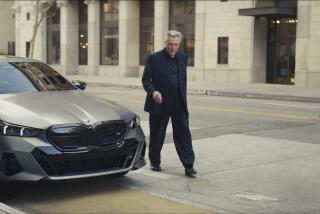NEW, CREATIVE GRABBERS : TV COMMERCIALS PLAY TO EMOTIONS
- Share via
The television commercial’s biggest competition was once the kitchen or the bathroom, but electronic advances of the 1980s have raised the battle for attention to new creative heights.
“It’s gotta be entertaining, it’s gotta grab the viewer,” said Josef Lubinsky, writer of music for the compelling, mood-soaked Levi’s 501 jeans commercials. “You can’t say, ‘Look here, this is the widget,’ anymore. You have to make the widget fly into space and come back down.”
Lubinsky, 32, is part of a crew devoted to finding ways of putting the widget in orbit with viewers, and the blast from their ideas may singe the stragglers.
Commercials are now aimed at grabbing emotions rather than feeding information. Some are mini-epics that evoke patriotism, romance or a particular life style in just 30 seconds.
These new-wave commercials typically are aimed at affluent baby boomers and feature either a catchy new jingle or a hit song from the 1960s, platinum production qualities and little or no announcing.
Lubinsky and others attribute the new creative approaches to the influence of MTV, which also is counted as one of the competing interests for today’s advertisements. Viewers sometimes switch to the cable-delivered music video channel as an escape from ads.
There’s a lot riding on keeping commercials interesting. Advertisers spent more than $20.7 billion last year for all types of television, according to Advertising Age magazine.
In the Levi’s commercials, moods and ideas come across in music and visual settings. In half a minute, the viewer has identified the jeans with living in New York City lofts, strutting down streets and falling in love.
Ford’s Lincoln-Mercury cars chase down Big Chillers with rerecorded versions of such 1960s hit tunes as Steppenwolf’s “Born to be Wild,” Creedence Clearwater’s “Proud Mary,” and the Beatles’ “Help” and “Good Day, Sunshine.”
Lubinsky works with partner Ron Hicklin in their HLC jingle agency, home of such hummers as “What the Big Boys Eat,” for Wheaties and “You Are the Dreamer” for the Wall Street Journal. The Los Angeles agency produces about 20 songs a week for various clients.
“What we have done is change the way people look at commercials,” Lubinsky said. “Now they’re not so much a story being told as an emotion being conveyed.”
Viewers always had the option of ignoring commercials, usually by leaving the room. Programmers retaliated by cranking up the volume, so that the ad spiel followed viewers around the house like a pesky salesman.
Five years ago, commercial makers faced the simultaneous emergence of widespread cable television, videocassette recorders and upgraded remote controls for television sets.
A remote control, especially combined with cable TV, gave viewers the option of switching to other shows during a commercial, a practice the industry calls “zapping.”
A viewer could also hit the mute button, the electronic equivalent of punching out the huckster. On videocassette machines, viewers skip fast-forward, or “zip,” through recorded commercials.
Amid the zipping and zapping, advertisers got the message: Match MTV or die.
“If there’s any kind of trend, it’s that music has finally reached the status of being as important as the picture,” Lubinsky said. “As recently as five years ago, people who wrote music were in the back seat. The trend now is to get the music first, and have the director shoot the video.”
When Young and Rubicam in Detroit decided to change public perception of the Lincoln-Mercury Cougar, they settled on music and image as the message. Using the hit songs of 20 years ago to appeal to customers aged 25 to 44, the result was a series of 1960s music videos featuring a 1980s car.
“The traditional commercial that just says ‘the product that does this and that’ tends to put people to sleep,” said Chuck Snearly, a spokesman for Young and Rubicam.
“We first wanted to get on the right people’s shopping list. Then we can follow up with information about the car through printed ads and brochures,” he said. Since the campaign started two years ago, the average age of a Cougar buyer has dropped from 44 in 1983 to 35 in 1986, Snearly said.
More to Read
Inside the business of entertainment
The Wide Shot brings you news, analysis and insights on everything from streaming wars to production — and what it all means for the future.
You may occasionally receive promotional content from the Los Angeles Times.










